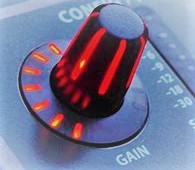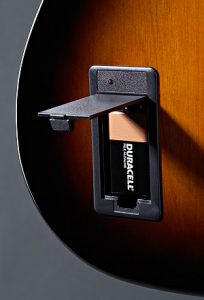(Editor’s Note: Hey, gearheads! Teaj here. Please help me welcome a good friend of mine, fellow G.A.S. sufferer and new blog author to our site: Mr. Sean Barrett. He’ll be sharing his expertise in the pro audio field from time to time, and you’re sure to dig what he’s layin’ down. Take it away, Sean… !!)
Space. The final frontier.
These days are pretty exciting for anyone who ever wanted mankind to explore the cosmos. I’m certainly one of those.

According to our pioneer man, Elon Musk, just a few years from now we’ll have a colony on Mars. AWESOMMMMME!!
But how will we get there? And what does that have to do with today’s topic: How to Gain Stage???
Well, to make it Mars, or anywhere far out into space, very precise calculations MUST be made.
It’s not a matter of just “heading THAT way”, either. On any outward bound journey, a colonizing ship is going to have to make a series of course corrections in order to make it to the final landing point.
Each time they adjust their trajectory, these course corrections could cause them to overshoot or undershoot their goal. But IF they are careful… methodical… they will reach their optimal goal and plant the flag of success on new worlds untold!
Gain staging is the same concept; it’s basically a series of ‘course corrections’ that will lead us to the ultimate goal,which is… sounding amazing!
Ready to blast off?!
Launch Time: T Minus Five Paragraphs…!

This is Part One in a series of articles that will help to solidly define and give examples of “Gain Staging“. Today’s post specifically will look at the “launch” phase – where your sound starts and how to navigate from there forwards to your goal.
Some of you may have never heard of gain staging. That’s okay. It’s not talked about much. That’s probably because it’s not well well-understood.
Today, we’ll hopefully change that, so we can apply, with informed confidence, the changes to our guitars and rigs that will take out tone “to infinity and beyond” (to quote a space-daring pioneer)!
One caveat before we dig in: there is, admittedly, no right or wrong when it comes to your sound. Tone is a completely subjective matter, and opinions are like @#%holes – we all have one!
So instead of defining a “right sound or method”, we seek today to make sure that everyone understands the gain staging procedure well. That way your personal guitar sound is not an accident, but rather a product of strategic creation, an informed blueprint… a deliberate series of course corrections.
Commence Stage One Separation…
So, what is “Gain Staging”? Gain staging is best expressed by this simple explanation: “One volume source feeding another, while specifically seeking to minimize distortion and noise”.
Another way of looking at it is this: a Gain Stage is any point in an audio signal flow where you can make adjustments to the level of the signal.

Also, let’s define our terms. What is GAIN? It’s simply the amount of signal output, measured in decibels, that a device is sending forth.
We all want the best tone possible, right?! Well, a big part of that is making sure that our tone is clear, and unadulterated by hiss and fuzz, or as we say in pro audio, keeping a good “signal-to-noise ratio”.
We often forget that every step in our audio chains, from fingers to speakers, can affect our sound dramatically. Because of that, we need to know how to wisely manipulate EACH STEP towards a clean, strong, emotionally-impactful tone that will cause our adoring fans to go ga-ga!
The biggest offenders in “breaking the chain”, as Fleetwood Mac spoke about, are electric guitarists. For that reason, this article is directed mostly at those of us riding those electric sound rockets.

But wait! If you play any instrument that needs more than one cable to be heard, then you will still benefit from understanding gain staging. Just apply the principles to your own instrument, step by step, with the same goal in mind.
So, electric guitarists… you know your weakness – you collect so much gear! And these days (in case you haven’t noticed), it’s a trend to have a lot of stomp boxes.
That’s cool and all, but unfortunately stomp box chains often introduce quite a bit of whacked signal settings. To the unwitting shred-meisters, that just means it “sounds bad”.
Bottom line: if we’re gonna have all those magic little boxes, we’d better learn how to set them up so our tone doesn’t, in a word, SUCK!
Picking Up Where We Left Off
Gain staging is a balancing act of volumes. It’s like doing a tango, but with multiple partners. And in THIS scenario, having multiple partners will NOT cause your guitars to be smashed, your car keyed, or your personal life transformed into hell’s oblivion. lol
STAGE ONE of your sound launch is the volume output and signal-to-noise ration of your guitar PICKUPS.

Can you make adjustments to the signal level and noise here?? Yes, but not easily! Pickups are sold in different output levels, so you could install different pickups in your guitar to change this first gain stage setting of your signal flow.
Obviously that’s a lot of work, and not something you can do on the fly, but it IS a gain staging choice you can make.
See, some pickups can be noisier than others. Anything labeled “High-output Pickup”, for example – these will introduce a bit more noise naturally, as they kick out a LOT more volume than your typical pickup.
Do you know what type of output you have, in all the pickups, on all your guitars? It pays to know, and to gain stage accordingly.
If your guitar has more than one pickup, try this test for gain staging insight: Plug your guitar straight into your amp. Choose a clean channel with low gain. Turn the amp on, and turn the volume up so it’s moderately loud. Now use your pickups switch and listen to each one sequentially.
Hear any differences? Since you want your SIGNAL TO NOISE RATIO (S/N) as low as possible, listen for any hiss in each pickup. You might find one is giving you a lot more noise compared to the others. Now that’s something to remember when you’re using that guitar for a gig or a recording session!
Here’s something else to consider: make sure that the pickups you have in your guitar are the ones best suited for your music genre, personal style and/or song choices. Be deliberate about what pickup is in what position.
You probably don’t want a high-output pickup if you’re backing Enya, for example. 😉
Pump Up the Volume!!
STAGE TWO in electric guitar gain staging is the VOLUME knob and TONE knob. Both of these can heavily influence the clarity of tone and amount of noise in your signal. The best sound? Have your volume all the way up and your tone knob all the way on high. This will launch you with maximum clean “fuel” for your signal’s long journey to the speaker cone.

A few things to remember: the TONE pot does only one thing – it cuts high frequencies. It is not adding, or boosting, anything. All it does is reduce the amount of high frequency content in your signal.
Also, with regard to VOLUME knobs: you may have one, or two, or even three of these! If you have humbucking pickups, then the corresponding potentiometer knob is typically a 500K type. The pot linked to a single coil pickup is usually a 250K type.
But regardless of which type of volume pot you have, they all have this in common: When the volume knob is set around 8 or 9, the impedance is maximum and the output circuit will pick up the most hum and the most noise.
This is because of basic electronics – high impedance circuits, like volume pots, are just more sensitive and pick up hum and noise easily.
To mitigate this fact, simply keep your volume at ZERO when not playing, and keep it at TEN when you are playing, unless, of course, a certain technique demands it. This will keep the impedance AND noise/hum at a minimum.
As an added bonus, you also won’t lose any brightness in your tone if you keep the volume setting all the way up. Reducing the volume knob, even to 9 or 8, immediately rolls off some of the high frequencies.
Using A.C. to Make it HOT??
STAGE THREE is optional and not found on the majority of guitars and basses, but there are many who swear by it and wouldn’t use anything else. It’s called ACTIVE CIRCUITRY, or A.C. for short.
Our friend Luke gives a good explanation of the differences, in case you’ve not heard of active pickups, in THIS VIDEO.

How do you know if you have active pickups installed on your guitar?? Well, an active pickup requires a battery somewhere in the guitar to power the active pickup.
Turn your guitar around. Look for a battery port on the back of the guitar. It might be a little door that you can swing open with your fingers, or it might be a rectangular-shaped port that you’ll need a screwdriver to open. Either way, if it’s that shape, you probably have an active pickup.
Active pickups are great from the gain staging perspective for two reasons:
- They virtually eliminate any electrical noise, so you get a really clean signal right from the get-go.
- With their Volume knob you can adjust its volume to “play nicely” with the other pickups on your guitar, which are probably passive and don’t put out as much volume.
Watching Cable

Finally, STAGE FOUR is an oft-skipped crucial link in the chain: your GUITAR CABLES. I consider this a part of gain staging. Some don’t. To me it definitely should be because SO MANY have wrestled with noisy, “bleh” tone until they changed their cables and discovered their tone cleaned up and came alive!
To assure that your cables aren’t being part of your tonal and/or noise problem, make sure to:
- always keep your cable LENGTH at a minimum
- buy cables with braided or serve shielding, and avoid foil shielding
Cables made with only foil shielding tend to lose the war against noise; they pick up magnetic field interference from your other gear, as well as pesky radio frequencies. They’re okay if you’ll use them in short lengths, and for connections that will not be MOVED at all, since they break easier.
Yes, they’re cheaper, but NO… they are not one with the Force, young Padawan! 😉
We’ve Hit Quantum Distortions, Cap’n!

Anybody into rock ‘n’ roll distortion guitar sounds?! Raise your leather-gloved, metal-bracelet-wristed shred hands high!
Have you noticed that when you have your amp and/or effects set on a distorted tone, and you roll back your guitar volume knob, that not only does the volume go down, but the tone also gets less distorted??
Why is this? Because the volume knob (at whatever setting it is at) dictates the GAIN level to whatever signal comes next. It’s yet another example of how gain staging can really affect your sound.
You can see how this all adds up. Each unit in an audio chain will have its own gain settings: pickups; pedals; amplifier preamp… and each gain setting affects the volume and noise level in the next device in the chain. If we ignore gain staging, we can really make a noisy, tone-sick mess or our rig’s end product.
Remember this simple truth: the higher the output of a previous device, the higher the gain of the next unit in the audio path.
The Trajectory to Tonal Mastery!
Alright… so let’s recap the initial elements of guitar rig gain staging:
- First, know your pickups and what type of output they produce
- For the cleanest signal, have your Volume and Tone pots all the way up
- Use A.C. if it’s an option and if it complements your sound and musical approach
- Buy and use only quality cables

Keep your axe-slinger boots boogying down this yellow-brick road and you will always maximize your tonal potential.
The final word here is this: your ultimate guitar tone is only as good as the weakest link in your audio chain!!
So do your due diligence: gain stage your rig, and make EVERY link in the chain a strong one.
First Stage Separation Now Complete!

I trust we’ve demystified some of the concepts of gain staging today for you, such that you can approach your gear confidently.
Now you’ll know exactly what to do to achieve your best sound, end the quest for ultimate guitar tone, and pacify thousand rabid thousands of screaming fans that idolize and adore you for your intoxicating 4-, 5-, 6-, 7-, or even 8-STRING wizardry!!
One thing is sure: staying informed as a musician will always address problems more efficiently. Greater understanding = better and faster control over our instruments, gear, and choices. So let’s keep at it.
Next up: Gain Staging, Part 2, where we will look further down the audio chain into PEDALS and AMPS.
Stay tuned here on Serious G.A.S. ‘Til then, peace out, Tone-chasers!!
Sean

Being a teacher for 30 years, I still learn some thing new everyday. I feel privileged to help my students, especially the ones that pay attention. Clearly, Vicki, you are one of them.
If there are any other questions you have regarding gear, you can contact me, or Teaj, through http://www.seriousgas.com. Thank you!
Very impressive, Sean! I’m not even a guitar player, but I love learning new things and you got me curious when I found part of this on my flash drive that was left in your computer. I enjoyed reading about gain staging and learning more about what you do and how talented you are, not only as a musician but also as a writer. Hoping to hear you play sometime soon. : )